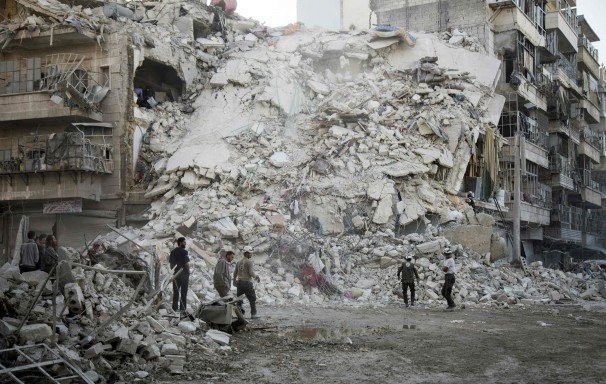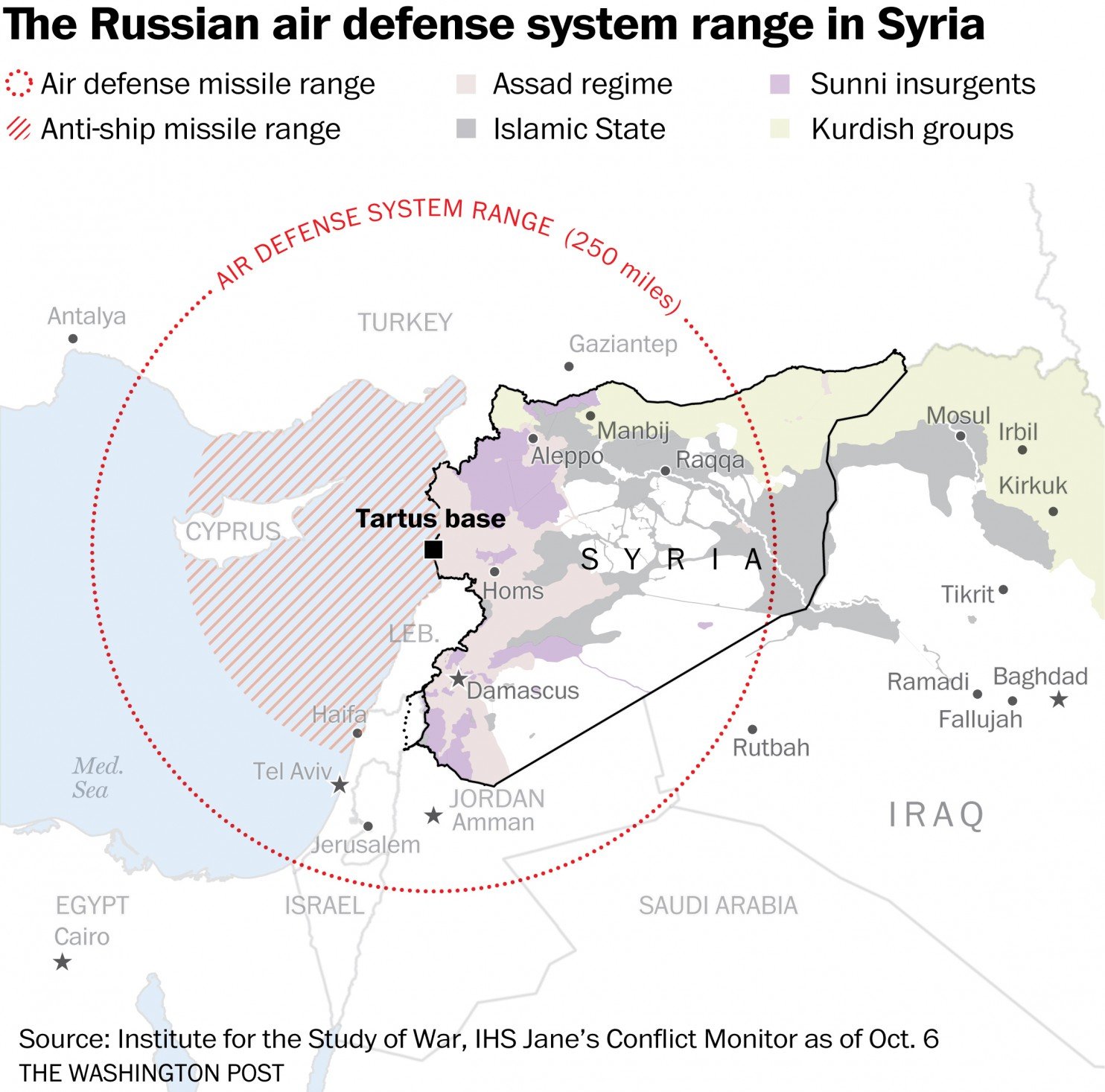Comment: The Russians have not only to a large extent neutralized the threat posed by the US Air Force, their most recent 'humanitarian pause' also undermines the alleged necessity of American established 'safe zones'. By giving the militants, civilians, and even terrorists time to leave East Aleppo, they're proving to the world that they actually care about who they hurt or kill. Unlike the Americans in their current siege on Mosul.
Deployment of mobile and interchangeable S-400 and S-300 missile batteries, along with other short-range systems, now gives Russia the ability to shoot down planes and cruise missiles over at least 250 miles in all directions from western Syria, covering virtually all of that country as well as significant portions of Turkey, Israel, Jordan and the eastern Mediterranean.
By placing the missiles as a threat "against military action" by other countries in Syria, Russia has raised "the stakes of confrontation," Secretary of State John F. Kerry said Sunday.
Comment: And necessarily so. Without the S-400s and S-300s, it's possible the US Air Force would already have its no-fly zone and be running roughshod over civilians and Syrian military alike in its quest to remove Assad.
While there is some disagreement among military experts as to the capability of the Russian systems, particularly the newly deployed S-300, "the reality is, we're very concerned anytime those are emplaced," a U.S. Defense official said. Neither its touted ability to counter U.S. stealth technology, or to target low-flying aircraft, has ever been tested by the United States.
"It's not like we've had any shoot at an F-35," the official said of the next-generation U.S. fighter jet. "We're not sure if any of our aircraft can defeat the S-300."
For more than two years, Syria has tacitly accepted U.S. and coalition airstrikes against the Islamic State, in areas relatively far afield from where the civil war is being fought. An agreement signed by Moscow and Washington last fall, after Russia sent its own air force to join that of Syrian President Bashar al-Assad, is designed to ensure that U.S. and Russian planes stay well away from each other.
Comment: If we are to assume that Assad is a brutal dictator desperate to hold on to power, which he isn't, then why would he tacitly accept help from the people looking to oust him? What an absurd attempt to hide the fact that the US has invaded a sovereign nation and is supporting an armed and bloody conflict there for its own imperialist desires.
But the ongoing Russian-Syrian siege of Aleppo, and the failure of diplomatic negotiations to stop it, has forced the administration to reconsider its options, including the use of American air power to ground Assad's air force.
The possibility of using U.S. air power in the civil war, even to patrol a safe zone for civilians, has never been favored by the Pentagon, which has argued that it would involve preemptory strikes on Syria's fixed air defenses. Now, with the installation of a comprehensive, potent Russian air defense system, many military officials see it as risking a great power game of chicken, and possible war, according to senior administration officials.
Several officials spoke on the condition of anonymity to discuss Russian capabilities and recent high-level White House meetings on Syria, Iraq and the Islamic State, including a Friday gathering of the National Security Council chaired by President Obama. The NSC session largely focused on the Mosul offensive begun against the Islamic State this week, and an upcoming operation against the militants in the city of Raqqa, their Syrian headquarters.
Consideration of other alternatives, including the shipment of arms to U.S.-allied Kurdish forces in Syria, and an increase in the quantity and quality of weapons supplied to opposition fighters in Aleppo and elsewhere, were deferred until later, officials said. U.S. military action to stop Syrian and Russian bombing of civilians was even further down the list of possibilities.
Another senior official dismissed what he called Moscow's "yard sale approach" of displaying all available systems to attract potential purchasers, and said last month's S-300 deployment did not much change Russian capabilities from where they have been over the past year. Russian arms sellers have repeatedly hailed the performance of their weaponry in Syria and claimed heightened sales abroad.
U.S. strikes in heavily populated western Syria, despite the presence there of al-Qaeda-affiliated forces of the Front for the Conquest of Syria, formerly known as Jabhat al-Nusra, have been few and far between, precisely to avoid the risk of civil war involvement and, more recently, confrontation with Russia.
Comment: The US can't move ahead with its plans to 'fight' Daesh and al-Qaeda affiliates, because every attempt reveals that they're actually supporting the terrorists in Syria and brings them closer to direct confrontation with Russia. Which they know they would lose.
An attack early this month that eliminated a senior Front official in Idlib province, in northwestern Syria, was carried out by an unmanned U.S. drone, with notice provided to Russia.
Moscow has denied that Russian and Syrian attacks have intentionally struck civilians, saying they are directed toward the Front, some of whose forces are mixed with the rebels in Aleppo and elsewhere. In early September, Kerry said the United States would join with Russia in attacking the al-Qaeda forces, in exchange for a Russian and Syrian cease-fire and the delivery of humanitarian aid to besieged civilians.
It was when that agreement fell apart — and the United States suspended contacts with Russia over Syria as hundreds of civilians have been killed in the brutal bombing of Aleppo — that the Russians moved to install S-300 missiles. They formed the final component of an integrated air defense system, along with S-400 and other surface-to-air systems previously deployed in and around Russia's Hmeimen air base in Latakia province along the Syrian coast.
Comment: The failure of that agreement was completely the fault of the US, and keep in mind that hundreds if not thousands of civilians will likely be killed and hundreds of thousands will be displaced by the American coalition in its 'liberation' of Mosul. Which it deems necessary to help free the people of Mosul, but considers completely unconscionable when it comes to Aleppo. Despite the situational similarities.
Amid widespread talk of U.S. "kinetic" action to stop the Aleppo slaughter, the Russian Defense Ministry warned of the "possible consequences," noting that "the range [of the defense systems] may come as a surprise to any unidentified flying objects."
Russian soldiers and officers, it said, were working on the ground throughout territory controlled by the Syrian government and "any missile or airstrikes . . . will create a clear threat to Russian servicemen."
In addition, the ministry said, following the Sept. 17 U.S. airstrike that inadvertently killed dozens of Syrian soldiers in eastern Syria, "we have taken all necessary measures to avoid any such 'mistakes' against Russian troops and military installations in Syria."
Neither the administration, nor either of the presidential nominees, has ever favored using U.S. combat forces in Syria's civil war. But the use of air power to create a zone inside the country where civilians could be safe from relentless airstrikes by Syria and Russia has long been advocated by regional allies and domestic critics of what is seen as a weak administration policy.
Comment: The US has no room to be critical when it comes to bombing civilians or civilian infrastructure.
Both Clinton and Trump have favored such a strategy — in Clinton's case, since she was secretary of state. Trump has advocated establishing a safe zone inside Syria as a way to stem the flow of Syrian refugees to Europe and this country.
But while such zones — protected by U.S. air power — were established during years past in Iraq, Libya and Bosnia, all were against relatively weak opponents and conducted under United Nations authorization. Neither presidential nominee has addressed the question of comprehensive Russian air defenses.
Comment: US 'civilian safe zones', aka no-fly zones, are not and were never meant to protect the civilian populations as evidenced by the humanitarian crises that currently exist in Libya and Iraq today. They are meant to give the US Air Force free rein to bomb a country and its peoples back to the stone age, so that proxy states can be set up and the nation exploited by the US and its corporate interests.
Although Kerry has continued to try to revive the cease-fire, U.S. leverage against Russia appears minimal. Following talks with Russian Foreign Minister Sergei Lavrov and U.S. European and regional allies last weekend, Kerry said that increased sanctions against both Russia and Syria were under consideration.
Meanwhile, Russia on Monday offered an eight-hour pause to the Aleppo bombing this week to allow Front militants and civilians to leave the city.





Comment: See also: